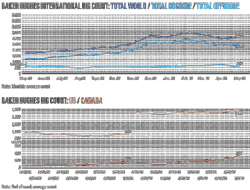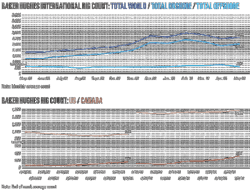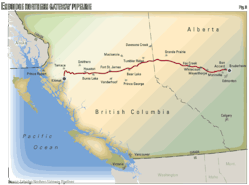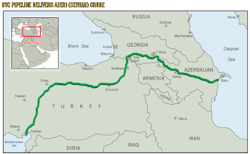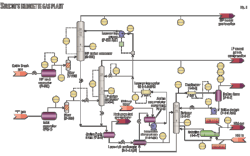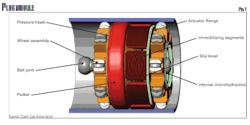Papua New Guinea has a well established oil and gas production region in the Highlands area of the country.
The commercial fields are largely restricted to a narrow fairway of Jurassic age clastic reservoirs in the Papuan basin. The deposits are mainly gas-condensate with some oil-only fields, and current known gas and liquids in place total 30.5 tcf and 1.247 billion bbl.
A second play, Miocene reefs in the western Papuan basin, is mostly biogenic gas, with limited geographic distribution; again, a narrow ribbon on a paleo-shelf break.
There is always a need to discover a new play to increase the prospectivity and hydrocarbon potential. Blue Energy Ltd. has done this and gone one step further in not only defining a new play type but also a large fairway in a new basin that is not explored. This article summarizes these exciting new concepts.
Deepwater play
The regional geological setting is shown in Fig. 1. The permits held by Blue Energy are PPLs 271, 272, 273, 274, and 330. They span deepwater offshore to transition to land on the southern peninsula of Papua New Guinea.
The deep water, steep slope, and the proximity of oceanic crust, ophiolites, high-grade metamorphics, and the surface have previously been used to downgrade the prospectivity of the region to zero.
However, the deepwater rocks are continental crust, and in fact the crust is thickening due to thrusting, so there is a hint of a possible subthrust structural play below the metamorphic and oceanic crust.
Blue Energy recognized these elements in its permits, and they form the basis of the subthrust play. With play development has come the need to reconcile known geological and geophysical results in the region.
With a literature review it quickly became obvious that little work has been done in the region. It has long been assigned as part of the Papuan basin, the eastern part or eastern Papuan basin. The proposal put here is that in fact it is a new basin, because a transfer fault separates the rigid Australian Plate basins from the Marginal Plateau basins.
There are some affinities with the Papuan Highlands fields, geology as well as onshore Australian Jurassic intracratonic basins in the pre-Coral Sea rift section, luckily as this contains the Mesozoic petroleum system. The challenge is to identify and confirm the petroleum system, and reports of oil seeps onshore in PPL 330 indicate that such a system does exist.
Coral Sea development
The basin has had an interesting tectonic development (Fig. 2): Paleozoic (Permian and older) Gondwana sag basin deposition followed by Triassic-Jurassic-Cretaceous Gondwana synrift and postrift, where the rift was to the north. This makes the basin the last easterly Tethyan basin, and it is as yet undrilled.
This is followed by a second rift phase in the south, the Coral Sea opening, in the Late Cretaceous Early Tertiary. There was associated doming to the south as well as dislocation of the plate to form marginal plateaus that moved to the north, separated from the Australian Plate by a transfer fault.
There was continued spreading in the northern Melanesian island arc, which ceased in the Eocene and reversed in the Oligocene. There was collision between the arc and the Papuan basin at this time, but much later with the new basin, probably in the Miocene. Fold and thrusting occurred in the Pliocene, and then later inversion. The potential petroleum systems with this structural development are shown in Fig. 2, with the interaction of sea level changes and tectonic events.
The region has been deemed to have little potential due to high risk in source, reservoir, and charge.
- Reservoir risk—due to restricted distribution of Toro sandstone reservoir or equivalent.
- Charge risk—generation timing is critical to migration pathways and capture in developing anticlinal traps.
- Source risk—extent of downcutting of the Coral Sea unconformity into the Mesozoic Petroleum System, possibly removing the source rocks.
Time space plots show three major tectonic events characterized by structural rotation and erosion (Fig. 2). The Gondwana tectonics is a rift system with northward dipping normal faults and rift axis to the north. The Coral Sea unconformity is also associated with a seafloor spreading center, normal faults dipping to the south, and also a major transfer fault between the stable Australian Plate and the Marginal plateaus.
The collision event has created uplift and later downloading. So when considering the seismic interpretation of the basin, there is a need to look for three unconformities that are in effect the boundaries of three supersequences (megasequences, to quote current literature). There are numerous eustatic events, but with no rotation. So in fact these eustatic-derived unconformities will be parallel unconformities and in fact difficult to see on seismic.
Seismic stratigraphy
Considering the regional gross section (Fig. 3) and zoomed region in Figure 3 and applying some seismic stratigraphy, it is possible to start to unravel the basin.
Seismic stratigraphic analysis shows starting from the bottom (oldest) and working up the section: Marginal plateaus are always relatively deep, so there is a need for a major event to lift, rotate, and subaerially erode the plateau.
The peripheral bulge is interpreted as the Coral Sea hinge zone where there is a transition between southerly dipping faults (Coral Sea opening related) to northerly dipping faults (Gondwana breakup related), and older sediments to the north have not been eroded out.
This is the central realization of the new play of a Tethyan petroleum system. The Gondwana breakup unconformity is characterized by angularity, rotation, and terrestrial section grading to deep marine. There is a thinning wedge to the south as expected as well as no thickening on immediate post sediments, hence no evidence of loading. The Jurassic coal event is characterized as cyclic, low frequency, bifurcation events, local unconformities, high amplitude, and evident even after 3 sec two-way time.
The signal strength is a key in assigning this as a coal event. There are few reflectors with sufficient impedance contrast to give such strong and coherent reflection packages. Salt and intrusives can be but are not the character seen on the section. The deep coal also is consistent with a terrestrial-lacustrine-shallow marine-deep marine transition, the rift-drift scenario of basin development. The shallow sediments, perhaps deep marine carbonates, are seismically "transparent."
The sediment thickening direction in the Mesozoic related to the unconformity and not to volume creation due to downloading. The collision unconformity is evident and associated with the first thickening package, characterized as slope erosion and deposition with onlap with crustal thickening and associated downloading the implied tectonic regime.
The erosion on Pliocene implies the region was shallow-water at collision time, uplift then deepening with loading. The thrust faulting is evident as well as a detachment fault within a chaotic zone of poor coherency.
The fact that there is Eocene at coast implies massive nearshore anticline as the breakup unconformity is lifting at the slope. Or are there imbrications? More seismic is required inshore to answer this.
Seaward we note about 1.5 sec of sediment (precollision event), and to the north this increases to 3 sec, so this implies repeat section based on the Jurassic coal pick. Evidence for the detachment is that Miocene erosion to the left but not so much to the right of the detachment fault as well as a repeat section of Jurassic coals. Flat lying coastal zone could indicate anticlinal ramp thickening. In any case there are one, maybe two thrust sheets, and there may be additional plays within these sheets, in addition to the basement level plays.
Papuan differences
So, interestingly we can extend to petroleum system characteristics away from the concerns and limitations of the nearby Papuan basin.
With respect to the Jurassic coals, it is postulated there are coal cycles, so providing source, reservoir, and seal. It is thought that structuring and hydrocarbon generation and migration will be synchronous as there has been shallow cool source rock until the downloading has pushed the source rock through the oil window. This downloading just preludes the anticlinal structures.
The distance to Owen Stanley fault is probably the edge of the continental block—so there is 40 km of fetch and migration is south into anticline. The gross rock volumes and expulsion volumes have yet to be calculated, but they should be significant.
The slope angle on the frontal thrust is short and steep, then there is 40 km of relatively flat seafloor and topography before mountain ranges are developed. This leaves sufficient room to develop a petroleum kitchen and substantial fetch.
Also, this topographical flatness can be used to imply a thrust ramp and not imbrications of the thrust sheet. Otherwise there would be significant mountain building at the coast. There would be mountain building at the coast merging directly into the slope, which there is not.
Crustal thickening supports overthrust model, as does to some extent the geoid anomaly over Port Moresby of 127 m, indicating an extra thick or overelevated land mass. Onshore oil seeps imply an active petroleum system, and these are along the Eocene or mobile belt boundary as would be expected.
Future exploration
Issues that will be clarified with future exploration include the nature of basement in the region, important to answer if there is a Permian-Triassic source in the rotated fault blocks. Is there any deepwater potential, currently ignored but still possible? A Miocene reef play is probably associated with the collision, but there is no seismic data yet to support this.
What this means is that Blue Energy's acreage position has a footprint of over one third of a new basin. More importantly the acreage covers the entire prospective fairway in the new basin. By analogy with the highlands there will be a structural density of over 40 anticlines in the fairway, perhaps more.
This presents a ground floor entry into a new basin with a very large position and exceptional exploration potential and opportunity. With a coal source, the system will probably be gas-condensate, but a mature marine Jurassic source cannot be ruled out.
The authors
Michael Swift is exploration manager of Blue Energy Ltd.
Peter Cockcroft is a geologist and executive chairman of Blue Energy Ltd. He has managed successful commercial gas projects in Indonesia, Myanmar, Pakistan, and Thailand. He has been a director of public companies in the US, Middle East, Indonesia, India, and Australia.
Jimmy Haumu is a geologist with the Papua New Guinea Department of Petroleum and Energy, Petroleum Division, in Port Moresby.
China
Pacific Asia Petroleum Inc., Hartsdale, NY, has spud a coalbed methane well on its 100% owned 175,000-acre Zijinshan Block in China's Shanxi Province.
Zijinshan, 150 miles east of supergiant Sulige gas field and 350 miles west-southwest of Beijing, is flanked by several CBM blocks held by Chevron Corp.
Awarded to the company in 2008, the Ordos basin block is near the west-east and Ordos-Beijing gas pipelines and another pipeline under construction and dedicated to CBM.
Guinea
Hyperdynamics Corp., Sugar Land, Tex., let a contract to TDI-Brooks International, Houston, for a comprehensive oil seep study of the 31,000 sq mile concession off Guinea, West Africa.
Sample collection is to start in mid-October in three areas of known oil seepage.
Hyperdynamics let another contract to GeoMark Research Ltd. to test cores taken on and offshore from previous years to differentiate source rock ages ranging from possible Silurian, Devonian, Jurassic, Early Cretaceous, to Barremian/Turonian rocks.
Indonesia
Indonesia's first commercially drilled coalbed methane test well went to a TD of 1,950 ft in South Sumatra, cut a combined 90 ft of coal in five seams, and was cased to 878 ft. Ten more wells are planned by the end of 2009.
Operator PT Medco Energi Internasional Tbk, PT Ephindo of Indonesia, and CBM Asia Development Corp., Vancouver, BC, drilled the CBM-SE-02 well in the 58,349 ha Sekayu production sharing contract block.
Thicknesses are 20 ft in Palembang C, 40 ft in Palembang B, and in the lower Maura Enim unit, three seams totaling 30 ft of coal in Pangadang A. Medco shipped core from all five seams to the Geological Agency of Indonesia in Bandung, where gas content and saturations will be determined. An injection falloff test was successfully run in Palembang B to assess permeability.
More Oil & Gas Journal Current Issue Articles
More Oil & Gas Journal Archives Issue Articles
